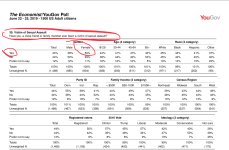Koyaanisqatsi
Veteran Member
It's not that it's the only conclusion you can draw from the data
Yes, it is.
but rather that there's no useful conclusion you can draw about how many were raped.
One can draw exactly two “useful” conclusions from the data: 1) that at least 1 out of every 2 women in America have been sexually assaulted at least once. 2) that the total number is likely higher.
All it sets is an upper bound.
Wrong again. Here is the question one last time: Have you, a close friend OR a family member ever been the victim of sexual assault?
That means no matter whether it was just you or it was you And a member of your family And a friend or friends, at least one incident of sexual assault will be counted.
So if anything it sets a lower bound, not an upper.
I strongly suspect this is from some piece-of-shit "research" designed to deceive those who read about it in the popular press.
It was a YouGov Poll, a screenshot of which I posted and you saw, reposted and responded to. Here it is again made idiot-proof:



